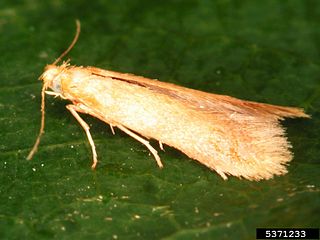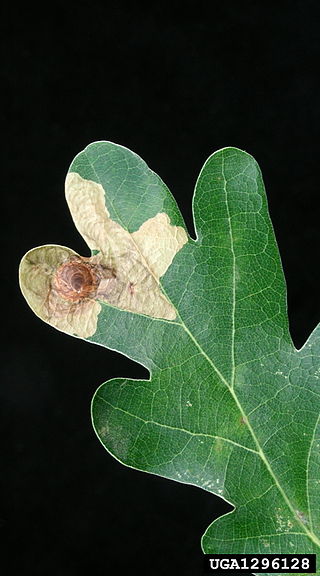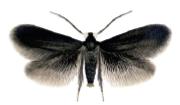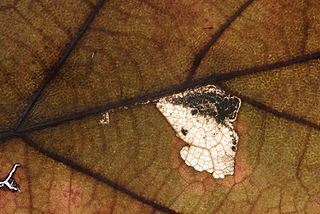
Quercus robur, the pedunculate oak or English oak, is a species of flowering plant in the beech and oak family, Fagaceae. It is a large tree, native to most of Europe and western Asia, and is widely cultivated in other temperate regions. It grows on soils of near neutral acidity in the lowlands and is notable for its value to natural ecosystems, supporting a very wide diversity of herbivorous insects and other pests, predators and pathogens.

Quercus petraea, commonly known as the sessile oak, Cornish oak, Irish oak or durmast oak, is a species of oak tree native to most of Europe and into Anatolia and Iran. The sessile oak is the national tree of Ireland, and an unofficial emblem in Wales and Cornwall.

Tischeria is a genus of moths in the family Tischeriidae. The genus Coptotriche was long treated as a synonym of Tischeria, but is now considered distinct.

Tischeria decidua is a moth of the family Tischeriidae. It is found in Central and Southern Europe, but has recently expanded its range and has been spotted in the Netherlands and Poland.

Tischeria dodonea is a moth of the family Tischeriidae. It is found from Fennoscandia to the Pyrenees, Italy and Romania and from Ireland to Ukraine. There is a disjunct population in eastern Russia.

Stigmella ruficapitella is a moth of the family Nepticulidae. It is found in northern and central Europe. It is mostly absent in the Mediterranean region, with the exception of Mount Olympus in Greece and Trieste. It has recently been recorded from Russia and Bosnia.

Stigmella atricapitella is a moth of the family Nepticulidae. It is found from Scandinavia to Ireland, the Iberian Peninsula, Sicily, Greece and Ukraine. It is also present in the Near East. It also occurs on Madeira, where it is most likely an introduced species.

Ectoedemia albifasciella is a moth of the family Nepticulidae. It is found in all of Europe except the Mediterranean Islands. In the east it ranges to the Volga and Ural regions of Russia.

Ectoedemia subbimaculella is a moth of the family Nepticulidae. It is found in most of Europe, east to Smolensk, Kaluganorth and the Volga and Ural regions of Russia.

Ectoedemia heringi is a moth of the family Nepticulidae. It is found from southern Great Britain and Ireland to Poland and further east to central Russia.
Tischeria ekebladioides is a moth of the family Tischeriidae. It is known from Spain, Portugal and Tunisia.

Tischeria quercitella, the oak blotch miner moth, is a moth of the family Tischeriidae. It has been sighted in North America in Ontario, District of Columbia, Illinois, Kentucky, Massachusetts, Missouri, New Jersey, Ohio, Pennsylvania and Virginia.
Tischeria ceanothi is a moth of the family Tischeriidae. It is known from California and Nevada in the United States.
Tischeria gouaniae is a moth of the family Tischeriidae. It is known from Belize.
Tischeria ambigua is a moth of the family Tischeriidae. It is known from California, United States.
Tischeria bifurcata is a moth of the family Tischeriidae. It is known in the United States from Arizona and California.
Tischeria urticicolella is a moth of the family Tischeriidae. It is known from the Democratic Republic of Congo.
Tischeria sparmanniae is a moth of the family Tischeriidae. It is known from South Africa, Zimbabwe and Namibia.

Coptotriche marginea is a moth of the family Tischeriidae, found in most of Europe. It was named by the English botanist, carcinologist and entomologist, Adrian Hardy Haworth in 1828, from a specimen found in England. The larvae mine the leaves of brambles (Rubus) species.

Heliozela sericiella is a moth of the Heliozelidae family found in Europe. The larvae mine the twigs of oaks, causing a gall.













